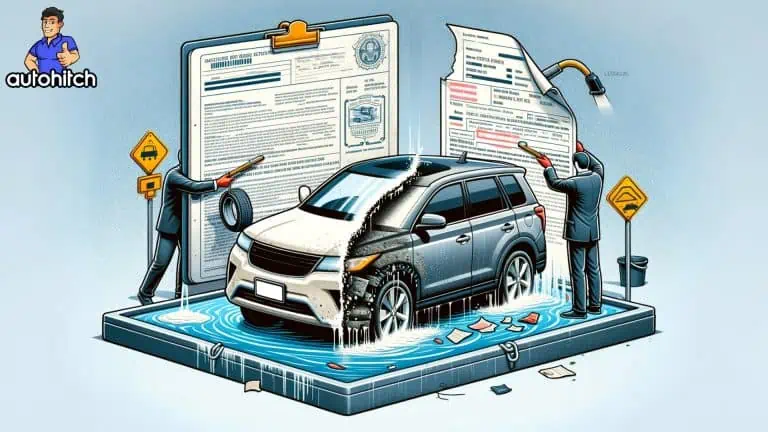Title washing is an illegal and common used car scam where unscrupulous individuals manipulate a vehicle’s title to disguise its troubled past, such as previous accidents, flood damage, or salvage history.
By understanding what title washing is, recognizing the red flags, and learning how to investigate a vehicle’s history, consumers can make informed decisions and avoid falling victim to this fraudulent practice.
Key Takeaways on Washed Titles for Quick Reference
- Definition: Misrepresentation of a vehicle’s history through manipulated titles.
- Legal Implications: Washing a Title is a serious offense, punishable by law.
- Self-Protection: Vigilantly use verified vehicle history reporting services to uncover potential title discrepancies.
Table of Contents
What Exactly is Title Washing?
Title washing is much more than a simple paperwork discrepancy; it’s a deliberate strategy to defraud vehicle buyers by presenting a damaged vehicle as if it were undamaged, which has legal, safety, and financial repercussions. Knowing the what, why, and how of title washing is your first line of defense.
Red Flags of Title Washing
| Potential Red Flag | Explanation |
|---|---|
| Inconsistent Vehicle History | The details on the title do not match the vehicle’s history report. |
| Altered Title Document | The title document shows signs of physical changes or forgery. |
| Seller Avoids Providing History Report | The seller is hesitant or refuses to provide a full vehicle history. |
| Unusually Low Price | The vehicle is priced significantly lower than its market value. |
| Rapid Title Changes | The vehicle has had multiple titles issued in a short time frame. |
| Out-of-State Title | The vehicle has a title issued from a state known for lax laws. |
A How To Guide On Washing A Car Title (Video)
Real-World Cases of Vehicle Title Washing
Below are several real-world cases involving this scheme:
- Operation Title Sweep: A joint operation between the Texas Department of Public Safety, FBI, U.S. Postal service, and other state and federal agencies led to the bust of a large group of title washing scammers who were estimated to have caused millions of dollars worth of damage to American consumers.
- Garrett Grable’s case: Garrett Grable bought a truck from a dealership that had committed odometer tampering and title washing. The dealership had bought the truck at an auction without a title, obtained an illegal title, and used it to sell the truck to Mr. Grable. The dealership was eventually ordered to pay $76,000 in legal fees and $52,500 in damages.
- Pennsylvania title washing scheme: The Pennsylvania attorney general’s office charged more than a dozen businesses and individuals in a car “title washing” scheme. The businesses, which included a title company, garages, and used car dealers, coordinated to purchase totaled vehicles, falsify inspection information, and submit fraudulent title applications to PennDOT. This fraud was designed to bypass requirements for reconstructed titles in states such as New Jersey and Massachusetts, or to make stolen vehicles look legitimate for resale or export.
Salvage Titles, Rebuilt Titles, and Their Relationship to Washing Titles
When investigating the past of a used vehicle, particularly to avoid title-washing scams, it’s crucial to grasp the significance of various title brands like salvage and rebuilt titles. Title washing often seeks to obscure these designations:
Salvage Titles
In the context of title washing:
- Original Intent: Intended for vehicles with significant damage—usually from accidents or natural disasters—and not worth the repair cost compared to their value.
- Title Washing Risk: Scammers may attempt to wash away the salvage brand to misrepresent the vehicle’s condition and history, selling it as undamaged.
Rebuilt Titles
Related to title washing:
- Restoration Indicator: Shows that a vehicle with a prior salvage title has been repaired and passed inspection.
- Title Washing Alert: A washed title may conceal the vehicle’s rebuilt status, leading buyers to believe they’re purchasing a never-damaged car.
Title Brands
Critical in detecting title washing:
- Definition: Marks indicating the vehicle’s history, such as “flood,” “theft recovery,” or “salvage.”
- Title Washing Tactic: Unethical sellers might use title washing precisely to eliminate these brands, falsely inflating the vehicle’s value and desirability.
Here’s a practical table highlighting these concerns:
Table: Interpreting Title Brands To Avoid Washed Title Scams
| Title Concern | Description | Implications | Buyer’s Actions |
|---|---|---|---|
| Salvage Title | Marks severe previous damage; often unsuitable for road use. | Scammers may hide this to sell at higher value. | Always request a full history report and an independent inspection to confirm the title’s validity. |
| Rebuilt Title | Indicates a once-salvage vehicle is repaired and roadworthy. | Title washing may omit this rebuilt history. | Verify the title status with your DMV and ask for documentation of repairs and inspections. |
| Specific Title Brand | Detailed descriptions of the vehicle’s past issues. | These brands are prime targets for washing. | Be wary and investigate any brands; seek legal advice if discrepancies are found. |
Individuals should be particularly skeptical of any vehicle that holds or once held a salvage or rebuilt title; these vehicles often become the focus of title-washing schemes.
Signs That a Vehicle’s Title May Have Been Washed
It’s essential to know that even a meticulously cleaned title can leave traces:
- Mismatched Details: Parts like panels or paint that don’t seem original or consistent.
- Inconsistent Reporting: A mismatch between the official title and the vehicle history report.
- Altered Documents: Any sign of manual changes, like different ink types or handwriting.
- Seller’s Reluctance: A seller that is dismissive about your concerns or the vehicle’s history should raise suspicion.
Understanding the Legal Consequences of Title Washing
- Criminal Charges: Individuals and dealerships involved in title washing can face heavy fines and prison time.
- Consumer Lawsuits: Buyers have the right to seek compensation in court for a fraudulent washed title.
- Regulatory Actions: Attempts are being made to enact uniform policies to deter title washing across different jurisdictions.
What To Do If You Are a Victim of Title Washing
If you’re a victim of title washing, take these steps:
- Report to Law Enforcement: Inform local police or your state’s attorney general. You can also report to the department of consumer affairs.
- Contact Attorney General’s Office: They often have specific channels for reporting title washing incidents.
- Seek Legal Advice: Consult a private attorney, possibly found through your State Bar Association, who specializes in consumer law or automotive fraud.
- Document Everything: Keep all documents related to your vehicle purchase, like the title and bill of sale, for potential legal action.
- Check for Recourse: If the vehicle was bought from a dealership, explore options with their parent company or franchise.
- Contact Consumer Protection Agencies: Agencies like the Federal Trade Commission or state consumer protection offices can offer guidance.
- Public Awareness: Share your experience online to warn others and prevent similar scams.
The Unseen Dangers of Title Washing for Buyers
The real cost of falling for a washed title can be steep:
- Economic Fallout: Purchasers pay much more than the real value of a washed-titled vehicle.
- Hidden Hazards: The risk of mechanical failures and safety issues increases, potentially leading to accidents.
- Proving Fraud: It can be challenging to establish fraud, requiring substantial evidence and possible legal assistance.
Steps for Consumer Protection: Going Beyond Basic Measures
Beyond checking the history report, deep-dive into vehicle assessments:
- Expert Inspections: Have a certified mechanic inspect the vehicle for any undisclosed problems.
- State Title Checks: Investigate if the car has records in multiple states.
- Insurance Records Review: Sometimes, insurance companies maintain a separate log of claims on vehicles that can reveal undisclosed incidents.
Broader Impacts on the Industry and Economy
Title washing isn’t just an isolated issue; it affects various sectors:
- Impact on Insurance: Washing titles can lead to underpriced insurance premiums and significant losses.
- Loan Risks: Banks and lenders are susceptible to offering loans on misrepresented vehicle values.
- Dealer Reputation: Honest dealerships may inadvertently sell washed titles, tarnishing trust and credibility.
A Look Ahead: Preventing Title Washing Through Innovation
Solutions are emerging that aim to stop title washers in their tracks:
- Legal Overhauls: Proposed legislation aims for nationwide consistency in title branding.
- Technological Defense: Blockchain and other tracking technologies offer new defenses against title alteration.
Closing Thoughts: Remaining Diligent in the Face of Fraud
Being forearmed with information and resources is crucial to navigating the used-car market and avoiding the pitfalls that come with vehicles that have washed titles. By remaining observant and knowledgeable, consumers can guard against deceitful practices and ensure the integrity of their vehicle purchases.
Sources and Citations
- https://bobistheoilguy.com/forums/threads/car-title-washing-facts.305709/
- https://www.autobodynews.com/30-individuals-21-businesses-charged-in-pennsylvania-title-washing-scheme.html
- https://www.wnep.com/article/news/local/lackawanna-county/state-charges-garages-car-dealers-with-title-washing-fraud-forgery-tampering/523-b38f67b3-69d4-4760-bc38-503749171c41
- https://www.njautolending.com/blog/signs-of-title-washing
- https://www.cars.com/articles/storm-surge-beware-of-title-washed-cars-1420668866539/



